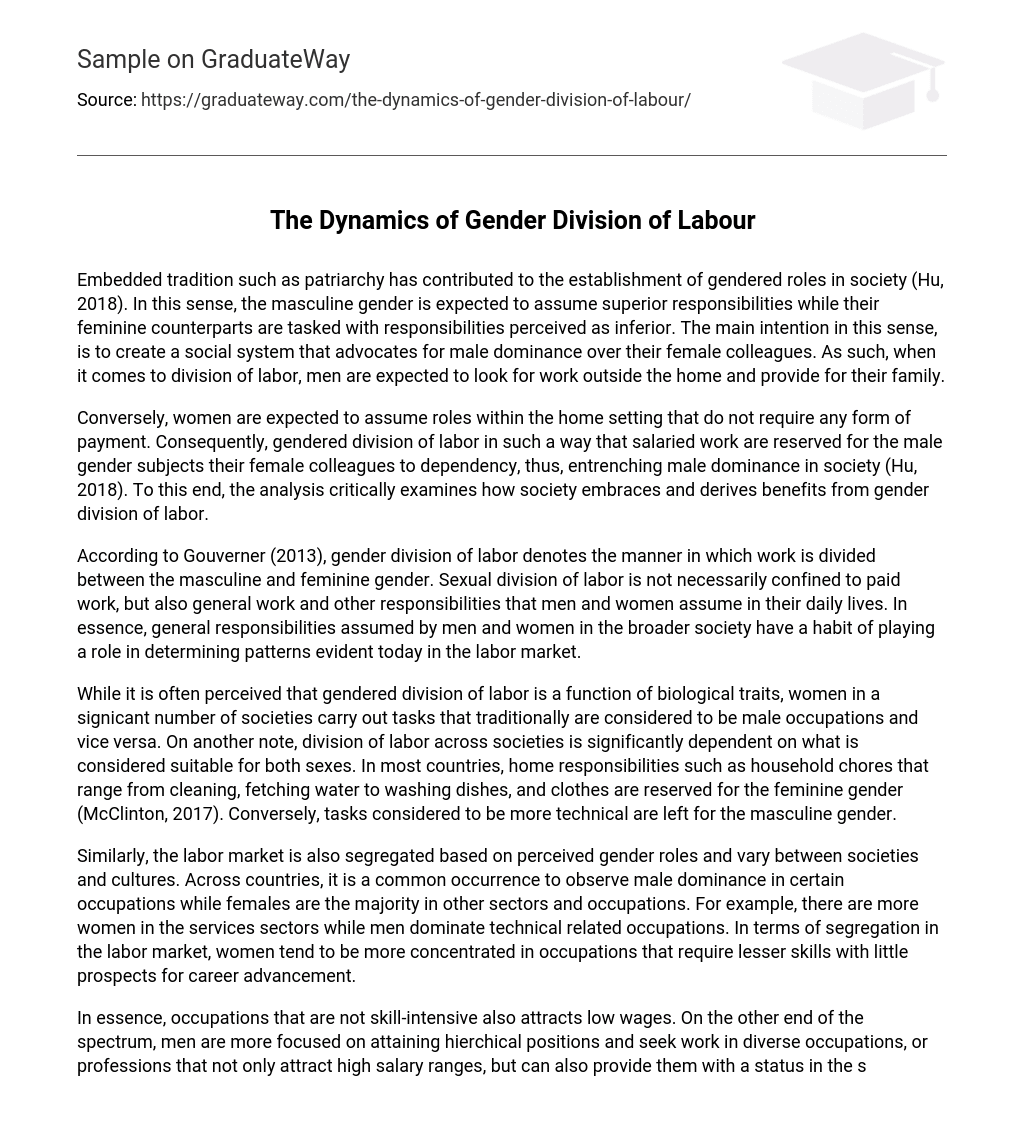Embedded tradition such as patriarchy has contributed to the establishment of gendered roles in society (Hu, 2018). In this sense, the masculine gender is expected to assume superior responsibilities while their feminine counterparts are tasked with responsibilities perceived as inferior. The main intention in this sense, is to create a social system that advocates for male dominance over their female colleagues. As such, when it comes to division of labor, men are expected to look for work outside the home and provide for their family.
Conversely, women are expected to assume roles within the home setting that do not require any form of payment. Consequently, gendered division of labor in such a way that salaried work are reserved for the male gender subjects their female colleagues to dependency, thus, entrenching male dominance in society (Hu, 2018). To this end, the analysis critically examines how society embraces and derives benefits from gender division of labor.
According to Gouverner (2013), gender division of labor denotes the manner in which work is divided between the masculine and feminine gender. Sexual division of labor is not necessarily confined to paid work, but also general work and other responsibilities that men and women assume in their daily lives. In essence, general responsibilities assumed by men and women in the broader society have a habit of playing a role in determining patterns evident today in the labor market.
While it is often perceived that gendered division of labor is a function of biological traits, women in a signicant number of societies carry out tasks that traditionally are considered to be male occupations and vice versa. On another note, division of labor across societies is significantly dependent on what is considered suitable for both sexes. In most countries, home responsibilities such as household chores that range from cleaning, fetching water to washing dishes, and clothes are reserved for the feminine gender (McClinton, 2017). Conversely, tasks considered to be more technical are left for the masculine gender.
Similarly, the labor market is also segregated based on perceived gender roles and vary between societies and cultures. Across countries, it is a common occurrence to observe male dominance in certain occupations while females are the majority in other sectors and occupations. For example, there are more women in the services sectors while men dominate technical related occupations. In terms of segregation in the labor market, women tend to be more concentrated in occupations that require lesser skills with little prospects for career advancement.
In essence, occupations that are not skill-intensive also attracts low wages. On the other end of the spectrum, men are more focused on attaining hierchical positions and seek work in diverse occupations, or professions that not only attract high salary ranges, but can also provide them with a status in the social sphere (Gouverneur, 2013). For example, majority of top jobs offered by corporations across the globe are occupied by the male gender.
As further pointed out by Federici (2012), gender division of labor is not static, but keeps changing based on emerging economic, political and social factors. For instance, the globalization phenomenon has contributed to a trend where both men and women migrate to other countries in search of greener pastures. As such, they are likely to work in different occupations without necessarily having to conform to the dictates of perceived gender roles.
Migration in search for work elsewhere has contributed to a shift in androgyny where men and women are likely to assume roles that are not socially ascribed in their embedded traditions, or cultures. For example, while working away from home, men may have to cook for themselves and women earning good salaries may assume the role of breadwinners for their families. Further, in efforts to seek greener pastures abroad, men who are accustomed to jobs that offer high status may resort to working in occupations that they are overqualified.
Such a trend is evident in industrialized nations where immigrants work in occupations that do not resonate with their academic credentials. Similarly, women working as immigrants in developed countries are the majority in occupations that do not provide possible opportunities for career advancement such as house maids, or caregivers (Federici, 2012). Overall, gender division of labor across societies is characterized by perceived gender roles that are significantly influenced by embedded traditions such as patriarchy that entitles men to superior positions in different occupations while subjecting women inferior roles.





